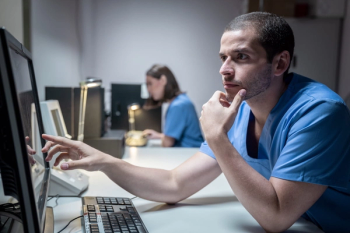
Lunate Dislocation
Clinical History: A 23-year-old male with a history of a fall on dorsiflexed right wrist. On examination, he had tenderness and mild swelling over wrist.
[[{"type":"media","view_mode":"media_crop","fid":"12338","attributes":{"alt":"","class":"media-image","id":"media_crop_7124424474614","media_crop_h":"0","media_crop_image_style":"-1","media_crop_instance":"471","media_crop_rotate":"0","media_crop_scale_h":"0","media_crop_scale_w":"0","media_crop_w":"0","media_crop_x":"0","media_crop_y":"0","title":" ","typeof":"foaf:Image"}}]]
Figure 1. AP View. lunate and capitate overlap.
[[{"type":"media","view_mode":"media_crop","fid":"12339","attributes":{"alt":"","class":"media-image","id":"media_crop_6714754686523","media_crop_h":"0","media_crop_image_style":"-1","media_crop_instance":"472","media_crop_rotate":"0","media_crop_scale_h":"0","media_crop_scale_w":"0","media_crop_w":"0","media_crop_x":"0","media_crop_y":"0","title":" ","typeof":"foaf:Image"}}]]
Figure 2. LAT View. Lunate seen displaced and angulated volarly giving appearance of spilled teacup.
[[{"type":"media","view_mode":"media_crop","fid":"12340","attributes":{"alt":"","class":"media-image","id":"media_crop_4237523712810","media_crop_h":"0","media_crop_image_style":"-1","media_crop_instance":"473","media_crop_rotate":"0","media_crop_scale_h":"0","media_crop_scale_w":"0","media_crop_w":"0","media_crop_x":"0","media_crop_y":"0","title":" ","typeof":"foaf:Image"}}]]
Figure 3. CT: Reformatted sagital images. Lunate seen displaced and angulated volarly giving appearance of spilled teacup.
[[{"type":"media","view_mode":"media_crop","fid":"12341","attributes":{"alt":"","class":"media-image","id":"media_crop_7694804663034","media_crop_h":"0","media_crop_image_style":"-1","media_crop_instance":"474","media_crop_rotate":"0","media_crop_scale_h":"0","media_crop_scale_w":"0","media_crop_w":"0","media_crop_x":"0","media_crop_y":"0","title":" ","typeof":"foaf:Image"}}]]
Figure 4. CT: Reformatted coronal images. This also shows fracture of ulnar styloid process.
Imaging Findings: AP radiograph - dislocation is often overlooked. Disruption of the normally smooth line made by tracing the proximal articular surfaces of the hamate and capitates.
Lateral radiograph - lunate seen displaced and angulated volarly giving appearance of Spilled teacup.
Plain film is normally sufficient to diagnose the dislocation. However CT plays an important role in assessing for associated occult fractures; the most common and important being scaphoid fracture.
Diagnosis: Lunate dislocation.
Differential diagnosis: Perilunate dislocation
Discussion: Lunate dislocations is an uncommon traumatic wrist injury that require prompt management and surgical repair. Lunate dislocations typically occur with high energy trauma resulting in loading of a dorsiflexed wrist. Lunate dislocations are far less common than the less severe Perilunate dislocation.
Sikander Ali Khan, MD
Consultant Radiologist
Royal Commission Medical Center, Saudi Arabia
Newsletter
Stay at the forefront of radiology with the Diagnostic Imaging newsletter, delivering the latest news, clinical insights, and imaging advancements for today’s radiologists.




























